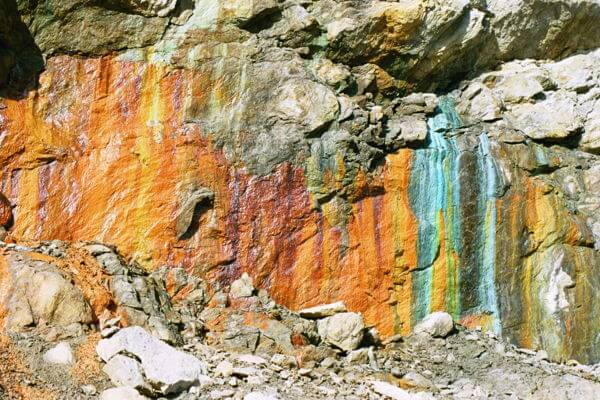Leaching Chalcopyrite is the holy grail for hydrometallurgists (Leachers), difficult to leach as the sulfur forms a layer over the mineral and makes the leaching slow. Having said that, it is not 100% not leachable, not unusual for ore dumps (low grade) containing chalcopyrite to be placed under leach but report low recovery +/-30% TCu over several years and the rate is around 0.5-1% per month. There are also different chalcopyrites such as enargite which is also primary with arsenic, as there is arsenic (defect) in the structure it leaches a bit faster but releases As which is bad for bugs.
Don’t get caught in the bacterial bug trap; many theories have people thinking the bugs are eating Cu, not so…there are various bugs; some are busy converting Fe+2 to Fe+3 which is the chemical leach and other bugs are consuming S and producing acid, which is used by the other bugs to make the Ferric…..complicated. Aeration helps the leach kinetics as it makes the bug thrive and party and when the bugs are happy the solution leaches more Cu. The air and acid are like the beer at the party which makes the bugs happy and they piss on the mineral releasing metal, maybe poor analogy.
There are also many tests and proprietary methods with high pressure/ high/medium temperature but that is different from heap leaching. I recall someone in Australia grinding the piss out of the rock (minus 400 mesh) and had reasonably good results.
Munoz (1977) reported that the mechanism by which chalcopyrite dissolves is by the continuous removal of iron and copper from the lattice with iron being removed first and then followed by removal of copper. The difficulty of leaching chalcopyrite under ambient conditions is generally considered to be surface passivation either from reaction products or adsorbed surface species layers, such as jarosite formation. The sulphur-rich layer presents a diffusion barrier to the continued dissolution reaction for copper. Hie initial kinetics of the reaction is uncertain and the sulphur or sulphur-rich layer is considered to form quickly. In general, the initial dissolution kinetics is considered to be quite fast, and then slows as the sulphur-rich layer forms. The rate of dissolution has been reported to be relatively insensitive to ferric concentration (Munoz et ah, 1979). At ambient temperatures, dissolution of chalcopyrite is limited and generally very minimal, and Paid et al. (1992) suggests that the initial kinetic rate can be ignored under these conditions because the sulphur or sulphur-rich product layer forms quickly. Kaplun used kinetic rate and shrinking core analysis to investigate the activation energies associated with chalcopyrite leaching at moderate temperature. In this study, it is assumed that the rate-determining step in the reaction kinetics is the transport of electrons through the elemental sulphur or sulphur-rich layer.
